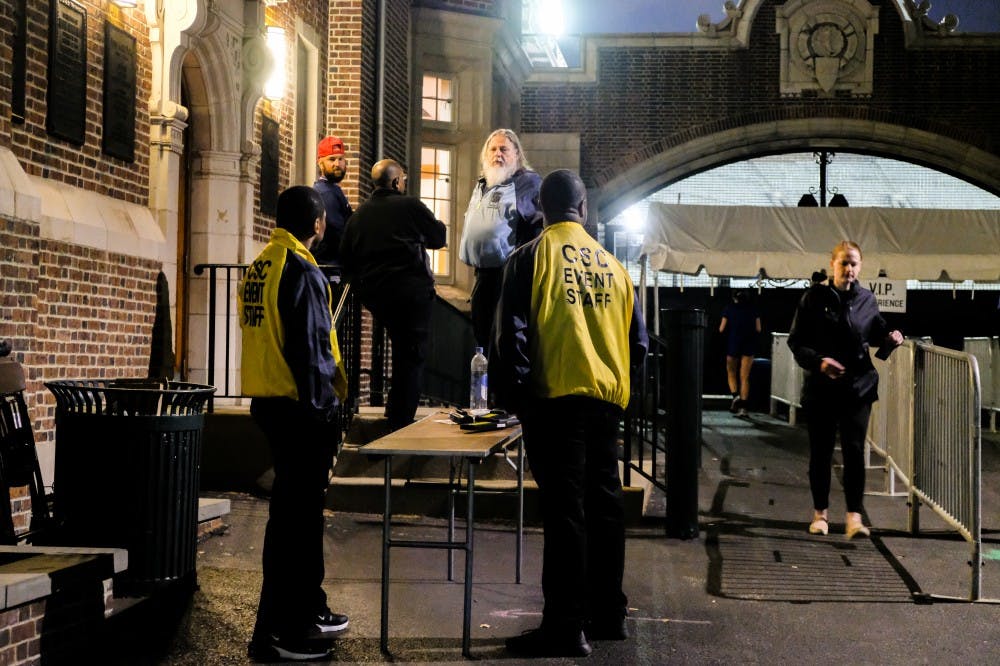Penn Relays — the world's first and largest track and field competition — requires tight security measures every year, including bomb squad dogs, security cameras, and a mounted police patrol unit.
Bomb dogs from four police divisions in Philadelphia swept the entire vicinity of Franklin Field on Wednesday morning in preparation for Penn Relays. The bomb dogs are a security measure added after the terrorist attacks on the World Trade Centers on September 11, 2001, Vice President for Public Safety Maureen Rush said. After the attacks, terrorism became a concern for Penn Relays, and the Division of Public Safety increased security and implemented a bomb disposal unit.
DPS has a command post at the event, where officers monitor security camera footage from various locations in the stadium. All incidents, such as medical illnesses or crimes, are reported in a log. There are three types of security personnel present at the event: police officers, Allied Universal Security Services security guards, and hired event security.
Penn Relays celebrates its 125th anniversary this year. Every year, top high school, collegiate, and Olympic-level athletes travel to Franklin Field to compete in front of an international crowd. The race attracts as many as 110,000 people. This year's event takes place from April 25 to April 27.
The area secured by DPS includes Penn Park, Franklin Field, and Shoemaker Green. Once secured, the stadium is guarded by security officers each night and will be monitored 24/7 until the end of the event on Saturday evening. DPS conducts sweeps for potential radiation danger as well.

Officers from the Philadelphia Police Mounted Patrol Unit will be present outside of Franklin Field on Saturday evening. 33rd Street will be shut down from Spruce to Walnut streets from about 6 to 7 p.m. to accommodate people leaving the event, and the horse-mounted officers will help to direct traffic.
Academic buildings are off limits for event participants, and there has been an increased number of Allied Universal security officers in David Rittenhouse Laboratory and the School of Engineering and Applied Science buildings, Rush said.
RELATED:
Penn ranks first in safety and security among higher education institutions
Van Pelt Library to eliminate bag checks starting this semester
A medical team will also be present at Franklin Field, including an orthopedic doctor, trainer, and physical therapist. Penn Medical Emergency Response Team and the Alternative Response Unit vehicle will also be available to support Penn Police outside the stadium.

DPS first revamped its security protocol for the Penn Relays around 1997, mainly because of traffic issues on the surrounding streets, Rush said. DPS works with the Philadelphia Police as well as the Department of Homeland Security in preparation for the event.
College sophomore Kacie Burton, who worked at the information desk for Penn Relays, said attendees have complained to her about the extensiveness of the security meausres.
“I think it’s pretty effective, to the point where it annoys some of the guests," Burton said.
While some were annoyed by the traffic caused by the amount of security, other event attendees said the security measures are essential for the number of people at the event.

Ciaran Scott, a high school junior at the Agnes Irwin School, participated in an event on Thursday. Scott said that the extensive security measures are good, especially considering the number of people and children who attend the event.
“I think sweeping in the area and having police guards and gates at every entrance is a good thing to do with this many people around,” Scott said. “It’s annoying when you’re running and you’re not thinking about it, but it’s definitely a good thing to have because if something were to happen, they would catch it.”
Caroline Shannon, another junior at The Agnes Irwin School, said she was surprised by the level of security that even the athletes had to go through.
“To even get in to the race we had to go through two sets of security, and it was an in-depth search of your bag when we first came in,” Shannon said. “It was more security than you have to go through to get into Made in America, and I’m sure that has just as many people.”









